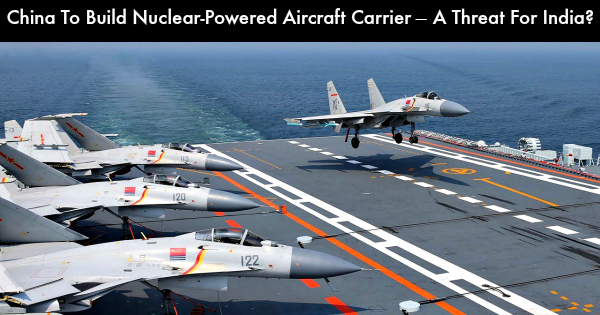China’s plan of transforming its navy into a blue-water force by 2025 gets a boost with the development of its first nuclear-powered aircraft carrier.
China is planning a larger, conventionally powered aircraft carrier that makes use of electromagnetic catapults to launch aircraft. It previously announced that there had been a breakthrough that will allow the ship to generate enough power to operate the catapults. Chinese Navy currently has aircraft carriers that can only launch using ski-jumps. This restricts their ability to operate aircraft such as turboprop-powered airborne early warning aircraft.
News Taken Down:
China’s state-owned China Shipbuilding Industry Corporation (CSIC) announced this in a news release. The original news release has now been deleted from the CSIC’s website and is replaced by one with vague references. The announcement by CSIC seems to be subsequently edited on the company’s website to remove the mention of nuclear-powered vessels, but it remains widely available on the Chinese internet. CSIC is China’s largest Naval Vessel manufacturer.
CSIC built China’s first home-built aircraft carrier, which was launched in April last year and is expected to enter service in 2020, once it has been fitted out and armed.
This is the first time a state-owned Chinese defence firm has openly identified nuclear-powered aircraft carriers on its agenda.
A “World Class Fighting Force”:
Chinese President Xi Jinping pledged in October last year to turn China’s military into a world-class fighting force by 2050 and has made new technology development a key policy plank, investing in stealth fighters, aircraft carriers and missiles.
Chinese state media has quoted experts as saying that the country needs at least six carriers, an endeavour expected to take decades. The United States operates 10 and plans to build two more.
Current Aircraft Carriers With China:
China commissioned its first-ever aircraft carrier, Liaoning, a refurbished Soviet ship it bought from Ukraine, in 2012. Its second carrier is the first domestically built carrier, known as Type 001A. It was launched in April last year. A third aircraft carrier, Type 002, is said to be under construction at the Shanghai Jiangnan Shipyard Group, although it has yet to be officially confirmed by authorities.
Increased Presence in Foreign Waters:
China’s navy has been taking an increasingly prominent role over the last year, with its first aircraft carrier sailing around self-ruled Taiwan and new Chinese warships popping up in far-flung places.
Due to the long endurance of nuclear-powered ships, China will be able to successfully carry out operations in far-off waters such as the Western Pacific and the Indian Ocean.
It is to be noted that the US military is periodically sending warships and air force jets to assert freedom of flights and navigation over the strategic South China Sea as China claims most of it. Vietnam, the Philippines, Malaysia, Brunei and Taiwan have counterclaims over the area. China also has a maritime territorial dispute with Japan in the East China Sea.
What does it mean for India:
There has been growing rivalry between Beijing and New Delhi in the Indian Ocean lately. However, considering the current growth rate, China is not likely to overtake India in naval strength in the region in the next two-three decades, despite increasing presence of the Chinese navy and planned new Chinese naval bases around SCS and IOR.
Also, with growing Pak-China ties, Pakistan’s ports on the Indian Ocean are widely expected to host a new Chinese military base in the near future.
India, however, secured access to naval facilities in Oman and Seychelles, along with having an upper hand in the Indian Ocean Region thanks to its geographical proximity.
China, on the other hand, has a very adverse land-to-coastline ratio. Its coast in the east is very far from the source of natural resources. Because of this, it needs to come to the Indian Ocean desperately as its economic power continues to grow.
“India is stronger in the Indian Ocean because China has to go through choke points in Southeast Asia. Their logistic line is very stretched. Although they have an aircraft carrier, it would take them a long time, probably decades, to incorporate that into an aircraft carrier battle group, which would allow them to achieve sea-control in the Indian Ocean. In this sense, it would take two-three decades. India still has a great advantage over the Chinese Navy in the Indian Ocean” – an Indian Naval Captain told Sputnik, an international media.







